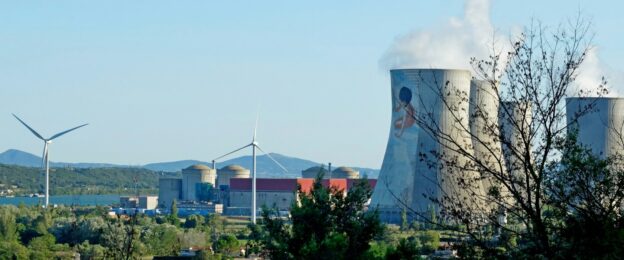- The global nuclear energy sector is experiencing a renaissance with increased interest and expansion plans, but faces the challenge of high water consumption for reactor cooling.
- Debates surround the actual water needs of nuclear power, with some arguing it uses more water than coal and renewables, while others claim water use can be managed with existing licenses and recycling.
- Advancements in nuclear technology, including small modular reactors and future designs using gas or air cooling, offer potential solutions to reduce water dependency, but concerns about increased nuclear waste persist.
A global nuclear energy renaissance is unfolding. Around the world, the public and private sectors are warming to the idea of nuclear energy expansion to meet ballooning energy demand driven by data centers without throwing decarbonization accords out the window.
The International Energy Agency projects that the world will produce more nuclear energy in 2025 than ever before. “More than 70 gigawatts of new nuclear capacity is under construction globally, one of the highest levels in the last 30 years, and more than 40 countries around the world have plans to expand nuclear’s role in their energy systems,” says IEA director Fatih Birol.
In the United States, approval ratings for nuclear energy have risen at a steady clip to reach 61%, nearly an all-time high. This marks an increase of six percentage points since Gallup’s last poll in 2023. Italy just overthrew a 40-year ban on nuclear power, and even Japan, which swore off nuclear entirely in the wake of 2011’s Fukushima tragedy, has indicated that they will return to nuclear energy in the coming years.
This renewed interest is concurrent with significant advances in nuclear technologies. Some countries have started to roll out Small Modular Reactors (SMRs) which have been buzzed about for years now as far more cost efficient and safe alternatives to traditional nuclear plants. As the name suggests, these small reactors are built offsite in a factory setting and shipped to where they are needed, allowing for standardization and automation that promises to revolutionize the global nuclear energy sector. Plus, these systems have built-in safety mechanisms that proponents say make them even less likely to melt down than traditional plants.
However, next-generation nuclear does have some key drawbacks as well. For one, studies have shown that SMRs will create more nuclear waste than traditional models. This presents a tricky and expensive problem, as the highly radioactive waste material remains hazardous for thousands of years in the best of scenarios. For another, nuclear energy is an extremely thirsty form of power production, requiring huge quantities of water to cool down the reactors for optimal particle speed for fission, as well as to generate steam to create electricity.
According to Dave Sweeney, a nuclear policy analyst at the Australian Conservation Foundation, nuclear power uses more water than coal, and “massively more than renewables” on a per-kilowatt basis. Sweeney was speaking with the Guardian in reference to a recent conflict between political parties in Australia over planned nuclear expansion and water scarcity. A report commissioned by the organization Liberals Against Nuclear found that a whopping 90% of the nuclear generation capacity proposed by the opposing Coalition party lacks sufficient access to water for safe operations. “Half of the proposed nuclear capacity was already unfeasible given insufficient water, while a further 40% of the capacity would need to be curtailed during dry seasons,” the Guardian reported this week based on the findings.
However, Coalition representatives say that these concerns about nuclear power’s water use are vastly overblown. “The first question I asked when we were looking at developing a nuclear policy was what impact it would have on water and I have looked at how much water is already allocated to power generation and am confident that there will be little difference,” Nationals senator Perin Davey told the Guardian. “Unlike Labor who want to turn our water into green hydrogen, our nuclear plan’s water needs can be met through existing water licences,” she added.
And luckily, according to the Breakthrough Institute, “nuclear reactors don’t need to be so thirsty.” In order to support the expansion of nuclear power, more strict guidelines are needed for water recycling processes at power plants. Moreover, nuclear reactor design is continuing to evolve, and some future reactors will rely on gas instead of steam, while others will use ail cooling, requiring far less water to operate.
https://oilprice.com/Alternative-Energy/Nuclear-Power/Nuclear-Energy-Expansion-Faces-Water-Resource-Challenges.amp.html





